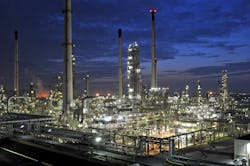Thai Oil lets contract for Sriracha refinery expansion, upgrading project
Thai Oil PLC has let a contract to Haldor Topsoe AS to license technology for the previously announced Clean Fuel Project (CFP) at its 276,000-b/d refinery at Sriracha, in eastern Thailand’s Chonburi province (OGJ Online, Apr. 11, 2017).
As part of the contract, Haldor Topsoe will deliver proprietary equipment and catalyst supply for its SNOX air quality-control technology to help secure compliance with air-emission regulations for a new energy recovery unit to be built as part of the CFP, the service provider said on Apr. 15.
The Sriracha refinery’s new energy recovery unit will use three parallel SNOX lines to remove sulfur oxides, nitrogen oxides, and dust emissions from the new circulating fluidized bed boilers. Sulfur will be recovered as commercial grade concentrated sulfuric acid, while nitrogen oxides will be reduced to free nitrogen, Haldor Topsoe said.
The refinery also will be able to use the SNOX process—which includes energy recovery by recycling of surplus heat to reduce energy consumption in the boilers—to handle additional sulfurous waste streams such as hydrogen sulfide gas, sour-water stripper gas, and Claus tail gas.
Without disclosing a specific value of this latest order, the service provider confirmed the contract follows Thai Oil’s previous awards to Haldor Topsoe for technology licensing to be implemented at the refinery, including a new hydrotreater to be added as part of the CFP.
With construction started in September 2019 and scheduled to begin commercial operation in 2023, the $4.825-million CFP involves retirement of two crude distillation units (CDU). The addition of a fourth, 220,000-b/d CDU to the existing third unit will raise the refinery’s total crude capacity to 400,000 b/d (OGJ Online, Mar. 18, 2020).
The project also will add a vacuum gas oil hydrocracker, a residue hydrocracker, a hydrogen manufacturing unit, a naphtha hydrotreater, a diesel hydrodesulfurization unit, a sulfur recovery unit, and an electric power plant fueled by residue pitch.
The refinery, now 100% dependent on light crude, will have a crude slate after completion of the project of 40-50% light crude, 5-15% medium crude, and 40-50% heavy crude.
The CFP also will improve product yields to 25% light distillate, 62% middle distillate, and 13% others, such as sulfur, long residue, and reformate, with no fuel oil.
As the private sector’s first megaproject in the Eastern Economic Corridor to position Thailand to become Southeast Asia’s energy hub, the CFP additionally aligns with current global market conditions and changing regulations such as the reduction in fuel oil use by marine transport as well as production of Euro 5-quality gasoline and diesel for improved environmental quality, Thai Oil said.
Thai Oil previously let a $4-billion contract to a consortium of Saipem, Petrofac, and Samsung for the CFP, under which the partners will deliver engineering, procurement, construction, and startup services for new units and upgrading of existing units (OGJ Online, Oct. 19, 2018).
The operator also signed a $757-million sales and purchase agreement with Global Power Synergy Plc (GPSC) for the electric power plant, or energy recovery unit (ERU), to be added as part of the CFP.
GPSC’s investment in the ERU—which will generate power and steam using petroleum pitch from the refinery as its main fuel—will help Thai Oil reduce its CFP investment burden by 15% as well as support the company’s financial status and increase its flexibility to effectively invest in other new projects in the future.

Robert Brelsford | Downstream Editor
Robert Brelsford joined Oil & Gas Journal in October 2013 as downstream technology editor after 8 years as a crude oil price and news reporter on spot crude transactions at the US Gulf Coast, West Coast, Canadian, and Latin American markets. He holds a BA (2000) in English from Rice University and an MS (2003) in education and social policy from Northwestern University.

